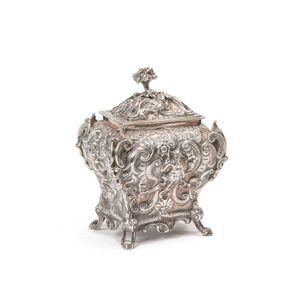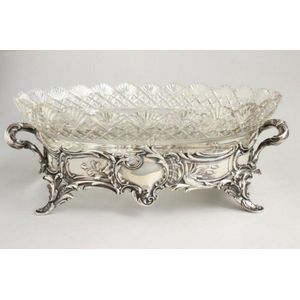Russian Silver and Crystal Twin Handled Centre Piece
You must be a subscriber, and be logged in to view price and dealer details.
Subscribe Now to view actual auction price for this item
When you subscribe, you have the option of setting the currency in which to display prices to $Au, $US, $NZ or Stg.
- Acanthus - A stylized leaf motif, one of the primary decorative elements of classical Greek and Roman architecture, derived from the genus of flowering plants in the family Acanthaceae, native to tropical and subtropical regions of the Mediterranean area. It is a common element in classical Greek and Roman design, and is often seen in Corinthian and Composite order columns and used as a decorative element in English, European and Australian furniture, particularly on the curve of a leg, and as decoration for a corbel.
- Pineapple - The pineapple, named because of its resemblance to a pine cone, was an exotic and scarce fruit in the 18th century. It became a popular decorative motif on furniture, silver ceramics, glass and clocks during this time.
- Oak - Native to Europe and England, oak has been used for joinery, furniture and building since the beginning of the medieval civilisation. It is a pale yellow in colour when freshly cut and darkens with age to a mid brown colour.
Oak as a furniture timber was superceded by walnut in the 17th century, and in the 18th century by mahogany,
Semi-fossilised bog oak is black in colour, and is found in peat bogs where the trees have fallen and been preserved from decay by the bog. It is used for jewellery and small carved trinkets.
Pollard oak is taken from an oak that has been regularly pollarded, that is the upper branches have been removed at the top of the trunk, result that new branches would appear, and over time the top would become ball-like. . When harvested and sawn, the timber displays a continuous surface of knotty circles. The timber was scarce and expensive and was used in more expensive pieces of furniture in the Regency and Victorian periods.
This item has been included into following indexes:
Visually similar items

A George IV sterling silver Chinoiserie tea caddy by John Wintle, London circa 1825, 17 cm high, 585 grams

A Victorian silver bowl. Maker William Comyns & Sons Ltd. London 1895, the pierced body with C scrolls, within a 'C' scroll and flower head scalloped border, the base pierced flared with conforming decoration, on four flared feet. 313 gm.

A pair of Paris Porcelain vases, painted with figures, within puce Borders 41 cm high, chips and repairs to both

1870s Austro Hungarian silver centre bowl with C-scroll and shell decoration flanked by handles with a gold wash interior. 750 grams
